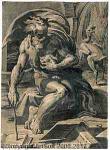Ugo Da Carpi
Ugo Da Carpi
Place: Carpi
Born: 1470
Death: 1523
Biography:
Ugo da Carpi was an Italian printmaker active between 1509 and 1532 in the cities of Venice, Rome and Bologna. He is renowned for his stylistic contributions to the chiaroscuro woodcut, a printmaking technique using blocks of different colours. Ugo claimed to be the first to use this technique, seeking a copyright first from the Venetian senate, and later from Pope Leo X. Although he did not create the chiaroscuro woodcut technique, he was one of the first Italian practitioners. He contributed to its development through his powerful style, focus on tonality and interpretive skills. One of his most famous works is a print of Diogenes. In addition to his numerous prints, he produced a writing book, and is also known to have produced at least one painting, the altarpiece of Saint Veronica in Saint Peter's Basilica in Rome.
Ugo da Carpi’s exact birth date is unknown. Some scholars estimate it to be as early as 1450, although others claim it is closer to 1480. He was the 10th of the 13 children of Count Astolfo da Panico and Elisabetta da Dallo. He was born in Carpi, a town in the province of Modena. He was known as Ugo Panico early in his life, only becoming Ugo da Carpi, which literally translates to "Ugo from Carpi", when he moved away from Carpi later in his life. The first historical evidence of Ugo is in the last will and testament of his father in 1490. There are records of Ugo buying and selling land in Carpi in 1495, 1496, and 1503. In 1509, records cite that his older brother carried out a land transaction for him, leading scholars to believe that Ugo left Carpi for Venice between 1503 and 1509. His wife, Cassandra Solieri, and two daughters stayed behind in Carpi.
There is no evidence that Ugo received any formal training. He was most likely self-taught or possibly taught by local painters. His first work as a carver was in 1502, when he signed a contract with the Modenese typographers Benedetto Dolcibelli and Niccolo Bissoli to carve characters and punches. In 1503, records refer to "Ugo's pupils" and reference him as a "maestro" for the first time, indicating he may have started a workshop. There is also evidence that before Ugo left Carpi he may have been commissioned to complete some paintings, since he hired Saccacino as a "painting assistant." Carpi went through a period of cultural and urban development in the late 1400s and early 1500s. Although there are no records of Ugo's involvement, scholars believe he may have helped in the production of some pieces during this time.
Ugo lived in Venice from 1509 to 1517, mostly working as a blockcutter for woodcut book illustrations. Venice was a leading publishing center, particularly the printing of illustrated books. In 1511, a number of woodcut book illustrations bearing the signature “Ugo” were published in Venice. In July 1516, Ugo requested a patent from the Venetian senate for what he claimed to be his unique chiaroscuro technique. In his request he described the process as a "new manner of printing light and dark." He requested the copyright for an undefined period of time, and for all designs and woodcuts he had made and would make. Although Ugo was an early Italian practitioner of chiarsocuro, there is evidence that this method had been previously used by German and Venetian printers.
Ugo moved to Rome in 1517. There was a large printmaking circle in Rome and high demand for prints of Raphael’s work. There was a circle of engravers working around Raphael, whose prints were issued by a professional publisher, il Baviera, Raphael's former assistant, who had gained control of his plates at his death. Due to il Baviera's tight control on the original copper plates used to print Raphael's engravings, creating pirated copies of Raphael's work became a common activity amongst engravers and printers in Rome. Ugo settled in Rome near Raphael's studio, but he worked independently of il Baviera.
He set up a workshop in his house and printed and published blocks in his own shop. In 1518, he received a copyright from Pope Leo X for his four-block print The Death of the Ananias. This work, along with many more of Ugo's chioscuro works from this time period, are considered by scholars to be the best examples of "truly reproductive prints." Although Ugo was focused on reproducing and replicating sketches, engravings, and prints by other artists while in Rome, he began to develop his own unique style. An early example of this is present in Ugo's replications of Raphael's sketches, where he chose colors for his prints dissimilar to the ones used by Raphael.
In 1527 the sack of Rome forced Ugo to flee to Bologna. It is believed he may have run a workshop in Bologna due to the existence of numerous prints that are technically and stylisticly similar to Ugo's work, yet also have some notable differences. He is known to have worked with the famous carvers Antonio da Trento, Arrighi and Eustachio Celebrino. Ugo also produced a writing-book while in Bologna. Writing books were common in Italy in the 16th and 17th centuries and contained pages of letters printed using wood cuts. These books were manuals and attempted to teach others how to write in a similar way to Renaissance humanist manuscripts.
More...
Wikipedia link: Click Here

